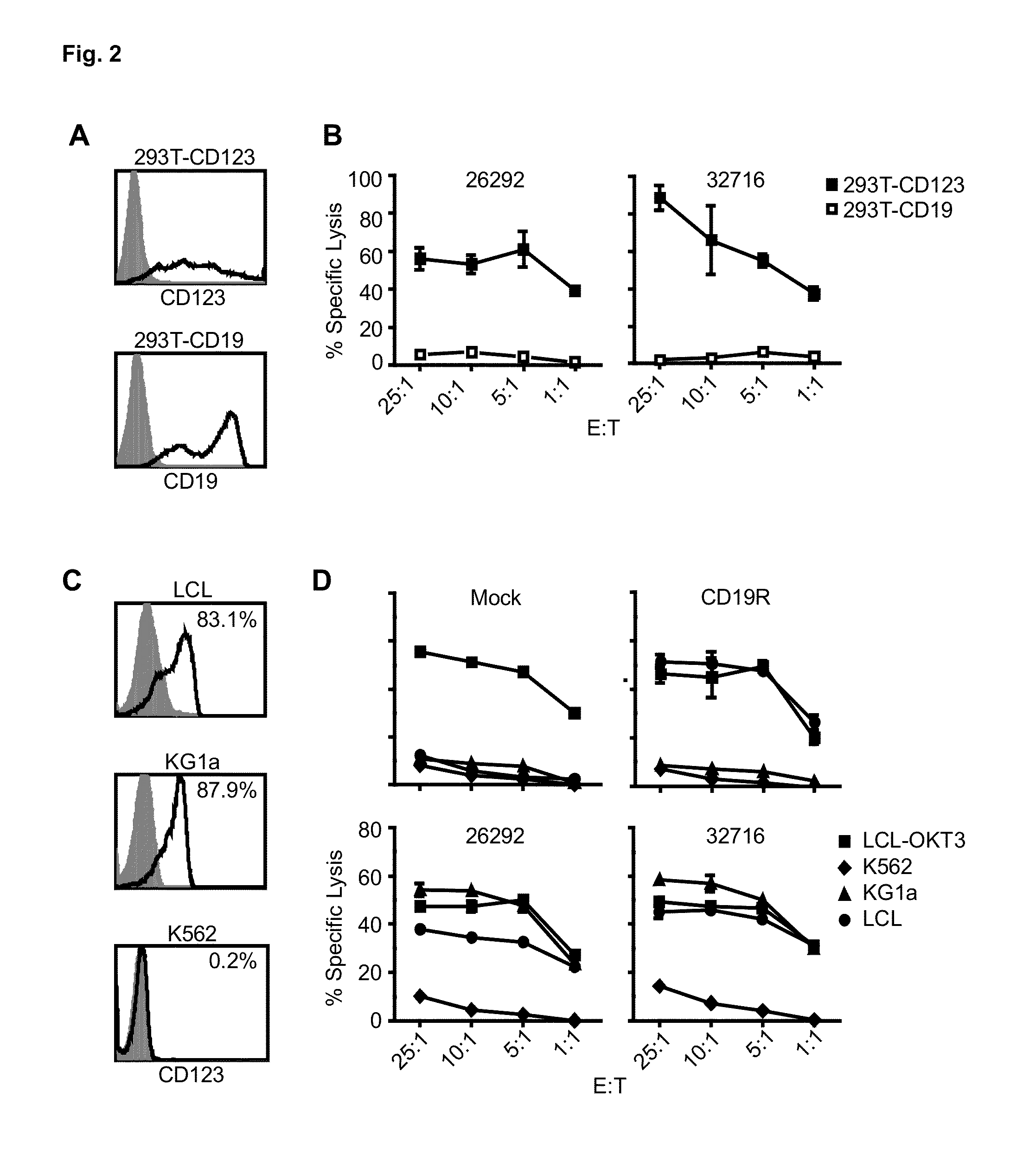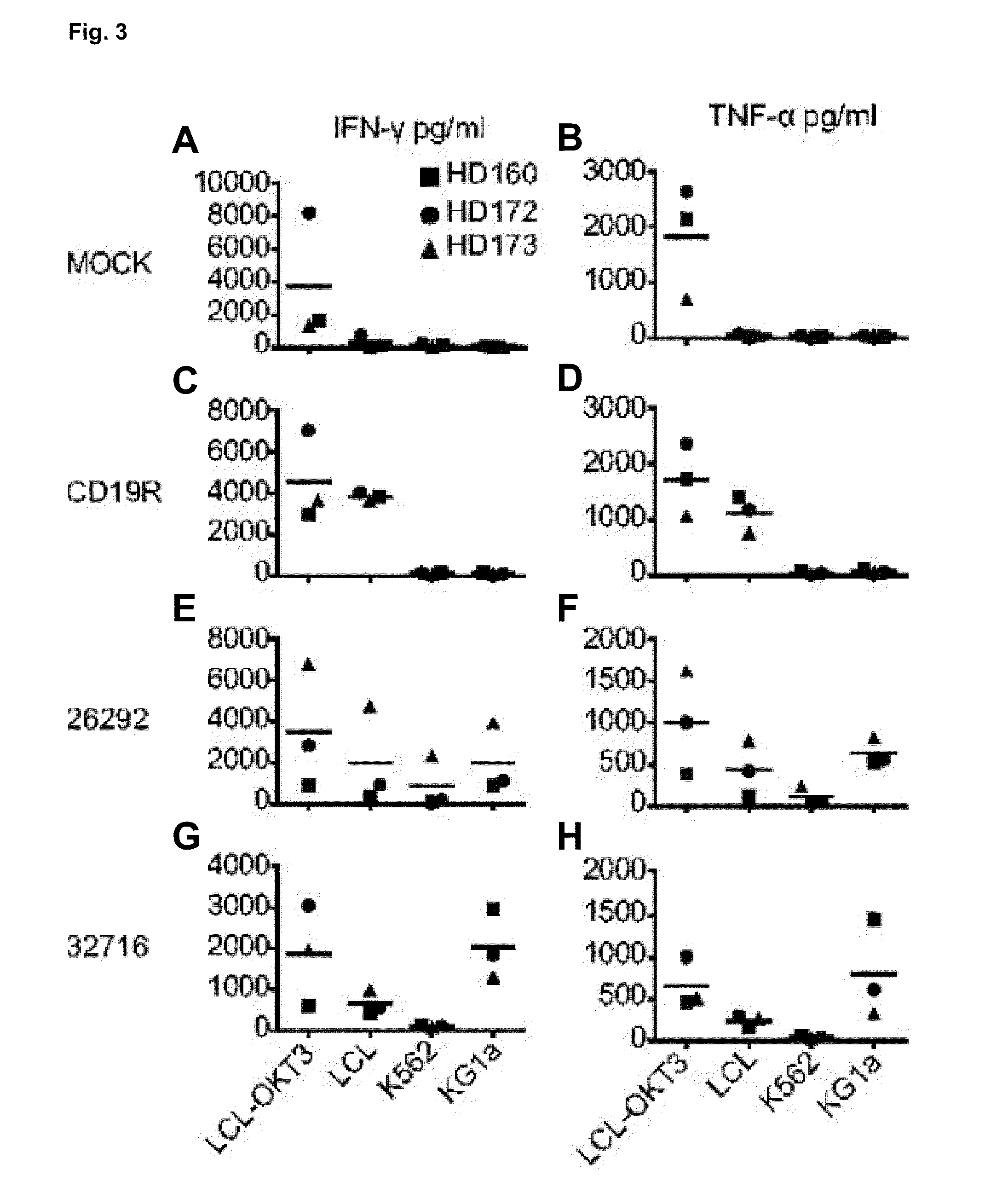Cd123-specific chimeric antigen receptor redirected t cells and methods of their use
a chimeric antigen receptor and t cell technology, applied in the direction of peptides, peptides, injected cells, etc., can solve the problems of limited efficacy, poor prognosis of aml, and hla-dependent targeting of aml, and achieve the effect of mediated potent effector activity
- Summary
- Abstract
- Description
- Claims
- Application Information
AI Technical Summary
Benefits of technology
Problems solved by technology
Method used
Image
Examples
example 1
CD123Car-Transduced T Cells Exhibit Potent Cytolytic Activity and Multiple Effector Functions Against AML In Vitro
Materials and Methods
[0097]Cell Lines.
[0098]Unless stated otherwise, all cell lines were maintained in RPMI 1640 (Irvine Scientific) supplemented with 2 mM L-glutamine, 25 mM HEPES, and 10% heat-inactivated FCS (Hyclone), hereafter referred to as complete media (CM). Peripheral blood mononuclear cells (PBMCs) were transformed with Epstein-Barr virus to generate lymphoblastoid cell lines (LCL) as previously described [19]. LCL-OKT3 cells express membrane bound OKT3 and are grown in CM supplemented with 0.4 mg / ml hygromycin [20]. K562 cells were obtained from ATCC and cultured as recommended. KG1a cells (kindly provided by Dr. Ravi Bhatia) were maintained in IMDM (Irvine Scientific) with 25 mM HEPES, 4 mM L-glutamine (Irvine Scientific), and 20% FCS. 293T cells (a kind gift from the Center for Biomedicine and Genetics at City of Hope) were maintained in DMEM+10% heatinacti...
example 2
CD123Car-Transduced T Cells Delay Leukemic Progression In Vivo
[0143]CD123CAR Constructs.
[0144]26292CAR(S228P+L235E) and 32716CAR(S228P+L235E) constructs were generated as described in Example 1 above. Two additional CD123CAR constructs were also generated that included an additional mutation in the IgG4 hinge at position 297 (N297Q) for each scFv (“26292CAR(S228P+L235E+N297Q)” and “32716CAR(S228P+L235E+N297Q)”) (FIGS. 12 and 13, mutations bolded and underlined).
[0145]NSG mice implanted with AML tumor cells (day 0), and were treated with 5.0×106 CAR+ T cells expressing either the 26292CAR(S228P+L235E) or the 26292CAR(S228P+L235E+N297Q) on day 5, and leukemic progression was monitored by bioluminescent imaging. As shown in FIG. 8, leukemic burden progressed on day 8 as compared to the day of treatment in mice treated with T-cells transduced with 26292CAR(S228P+L235E), indicating that cells transduced with the CD123CAR construct having hinge region mutations at positions S228P and L235...
PUM
| Property | Measurement | Unit |
|---|---|---|
| cell surface antigens | aaaaa | aaaaa |
| durable | aaaaa | aaaaa |
| relative fluorescence index | aaaaa | aaaaa |
Abstract
Description
Claims
Application Information
 Login to View More
Login to View More - R&D
- Intellectual Property
- Life Sciences
- Materials
- Tech Scout
- Unparalleled Data Quality
- Higher Quality Content
- 60% Fewer Hallucinations
Browse by: Latest US Patents, China's latest patents, Technical Efficacy Thesaurus, Application Domain, Technology Topic, Popular Technical Reports.
© 2025 PatSnap. All rights reserved.Legal|Privacy policy|Modern Slavery Act Transparency Statement|Sitemap|About US| Contact US: help@patsnap.com



